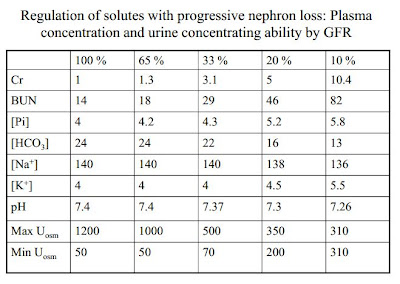1. Renal Tubular Acidosis
• Hyperchloremic, Non-Anion Gap, Metabolic acidosis
– Alkali loss: Intestine or Kidney?
• What should the kidney do in Acidosis?
– Secrete acid and retain alkali.
• Acid urine (U pH < 5.5)
• If the kidney is not excreting acid and retaining HCO3 then something is amiss?
Proximal RTA (type 2)
– Proximal Tubule
– HCO3 re-absorption is Dysfunctional
.
Proximal RTA
Impaired proximal tubule (PT) HCO3 absorption
• HCO3
reabsorption in PT is decreased
• Resulting in “Extra HCO3” in the urine (FeHCO3>5%)
• Serum HCO3 decreased
•Urine pH
• Low in acidosis
• High with treatment
• Distal RTA (type 1 & 4)
– Distal Tubule
– H+ secretion is Dysfunctional
Distal RTA type 1
Impaired Distal Tubule acid secretion
• Hydrogen ion secretion in the Distal Tubule is impaired.
• K+ reabsorption is impaired.
• H+ is not available to convert NH3 to NH4
+
• Limited acid excretion and new HCO3 creation.
• Urine pH is always high (>5.5)
Urine pH in RTA - not useful in diagnosing RTA
Can be High or Low
• Proximal RTA
– When Plasma HCO3 is low, the impaired proximal tubule can handle the reabsorption load resulting in an:
– Acidic urine.
– When plasma HCO3 is normalized (with treatment), the impaired proximal tubule cannot handle the filtered load resulting in an:
– Alkaline Urine.
• Distal RTA
– Final acidification of the urine occurs in the distal tubule via H+ secretion. This is defective in Distal RTA and hence:
– Urine pH is always aAkaline
Urine Anion Gap:
Urine (Na+ + K+) - Cl-
• Useful to differentiate the type of RTA
– It tells us about NH4
+ excretion:
U AG = Na+ + K+ + NH4 + = Cl- + HCO3
-
• Urine AG is Negative in Proximal RTA or healthy kidney
• Urine AG is Positive in Distal RTA.
• U AG is not accurate if:
– Dehydration, unmeasured ions are present (ketoacidosis) or
diuretics are in use.
How to Diagnose RTA?
• RTA likely exists when you have:
– Hyperchloremic, non-anion gap, metabolic acidosis.
– No extra-renal (i.e. GI) HCO3 losses
– No excessive intake of a Cl- containing acid
• Urine pH and Urine anion gap are useful to
differentiate the type of RTA.
Why do we care about RTA?
• Chronic acidosis leads to:
– Polyuria, failure to thrive and growth delay.
• Chronic hypokalemia causes:
– Nephrogenic D.I., urinary retention, ileus, muscle weakness / rhabdomyolysis and rarely cardiac arryhmias.
• Calciuria in Distal RTA leads to:
– Rickets and Kidney Stones.
• Associations with structural, auto-immune or metabolic disease:
– Obstructive Uropathy
– Cystinosis, Glycogen storage disease, Lowe’s syndrome, DM I & II
– Sjogren syndrome, Hypoaldosteronism
– Etc.
Management of RTA
1. Oral alkali: 1- 5 meq/kg/day*
– Na-Bicarbonate
– K- Citrate
*Alkali needs lessen with age
2. Evaluate and treat associated conditions.
Classification of RTA
• Proximal RTA (type 2)
– Dysfunction of proximal tubule re-absorption of filtered HCO3 .
– Often seen with generalized proximal tubular dysfunction
• Fanconi Syndrome: wasting of K+, HCO3, AAs, glucose, LMW protein, etc.
– Clinical Association: Cystinosis and Lowe’s Syndrome.
• Distal RTA (type 1 & 4)
– Dysfunction of distal H+ secretion and Ammonium (NH4+) generation
– 2 types:
• Type 1 - Low K+
• Type 4 - High K+ (due to lack of aldosterone activity)
– Clinical Association: Obstructive Uropathy, Hypoaldosteronism, Drugs or Chronic renal failure.
Metabolic Alkalosis and Hypokalemia
- Tubular Disorders
- Bartter’s Syndrome
- Defect in the Furosemide -sensitive distal Na-K-2Cl Transporter:
- • Salt (NaCl) wasting => polyuria, dehydration=> Renin-angiotensinaldosterone activation => Hypokalemic Alkalosis.
- • Birth Hx: Polyhydramnios
- • S/S:
- – Dehydration, constipation, vomiting, muscle weakness.
- – Polydipsia, polyuria, salt craving
- – Urine Calcium wasting
- – Failure to thrive and short stature
- – Hyper-Reninemia, but NO HTN
- Gitelman Syndrome
- Similar to Bartter’s, but milder.
- Hypokalemic Metabolic Alkalosis.
- Low –Magneseum level.
- Defect in the Thiazide sensitive Na-Cl transporter.
- High Renin, but no hypertension. (increase in vasodilatory PGs)
- May present later in life with fewer symptoms
- Liddle Syndrome
- hypokalemic alkalosis plus HTN
- Primary increase in collecting duct Na+ reabsorption and K+ secretion.
- Hyper-Aldosteronism -
- hypokalemic alkalosis plus HTN
- Persistent Vomiting
- hypokalemic alkalosis
- Self-Induced Metabolic Alkalosis
- • Surreptitious Vomiting or Diuretics
- – Anorexia / Bulemia
- • Dental erosions, calluses or ulcers on dorsum of hand, puffy cheeks (salivary gland hypertrophy).
- – Urine Cl-
- • Low with chronic vomiting or prior diuretics
- • High with diuretics or Bartter / Gitelman
- – Check Urine diuretic levels if needed.
- Diuretic abuse














